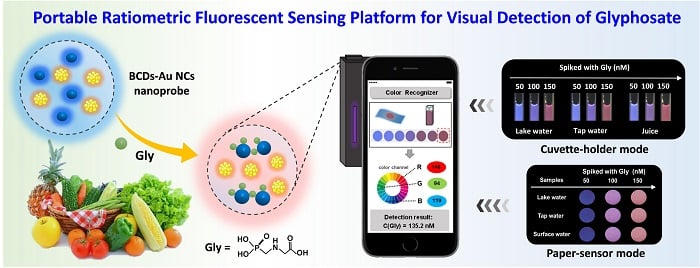S. Himmelstein | July 07, 2022
A selective strategy for rapid quantitative analysis of glyphosate pesticide residues in agricultural products has been engineered by researchers in China. The portable, enzyme-free analytical platform is based on ratiometric fluorescent nanosensors for the rapid visual detection of the organophosphorus pesticide.
Researchers from the Chinese Academy of Sciences, University of Science and Technology of China and Huainan Normal University combined 3D printing technology and a smartphone color recognizer app to develop the portable fluorescent detection platform for rapid visualization and quantitative monitoring of glyphosate under real-time/field conditions.
The sensor system incorporates blue carbon dots and gold nanoclusters. As glyphosate residues react with the carbon dots, aggregation-induced quenching leads rapid fluorescence quenching of these components. The orange fluorescence of the gold nanoclusters remains unchanged, serving as a reference signal and indicator of ratiometric fluorescence variation from blue to pink to orange.
 Schematic of the rapid visualization and quantification of glyphosate residues by ratiometric fluorescence sensor. Source: Zhang Qianru et al.
Schematic of the rapid visualization and quantification of glyphosate residues by ratiometric fluorescence sensor. Source: Zhang Qianru et al.
As reported in the Journal of Hazardous Materials, the method delivers visual and data detection of glyphosate within two seconds via fluorescence chromaticity changes. A detection limit as low as 4.19 nM is well below the maximum contamination level in the portable platform engineered for quantitative monitoring of glyphosate under field conditions.
